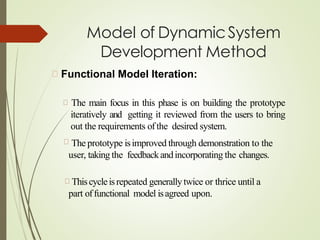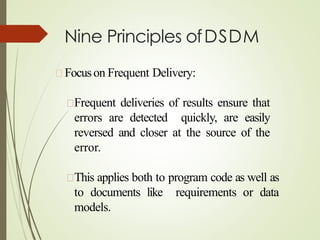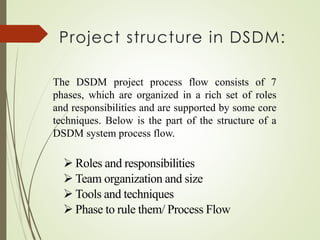Dynamics ystems development method
- 2. Personal Info: H. M. Nasim Id: 211-25-9** M.Sc. in CSE (DIU)
- 3. Dynamic System Development Method Dynamic System Development Method is approach to system development, which, as the name suggests, developsthe system dynamically. The Dynamic System Development Method (DSDM) is dynamic as it is a Rapid Application Development method that uses incremental prototyping.
- 4. Dynamic System Development Method DSDMisaniterative andincremental approachthat emphasizes continuous user/customer involvement. Its goalisto deliver projects on time andon budget while adjustingfor changingrequirements alongthe way. DSDMisone ofanumber ofAgilemethods for developing software andnon-I.T. solutions.
- 5. This method is particularly useful for the systems to be developed in short time span and where the requirements cannot be frozen at the start of the application building. Dynamic System Development Method
- 6. Model of DynamicSystem Development Method The method provides a four-phase framework consisting of:
- 7. Model of DynamicSystem Development Method Feasibility and Business Study In this phase the problem is defined and the technical feasibility ofthe desired application isverified. Only if the RAD is found as a justified approach for the desired system, the development continues. The overall businessstudy ofthe desired systemis done.
- 8. Model of DynamicSystem Development Method Functional Model Iteration: The main focus in this phase is on building the prototype iteratively and getting it reviewed from the users to bring out the requirements ofthe desired system. The prototype isimproved through demonstration to the user, taking the feedbackandincorporating the changes. Thiscycleisrepeated generallytwice or thrice until a part offunctional model isagreed upon.
- 9. Model of DynamicSystem Development Method Design and Build Iteration: Thisphasestresses upon ensuring that the prototypes are satisfactorilyand properly engineered to suit their operational environment The softwarecomponentsdesignedduring the functional modeling are further refined till they achievea satisfactory standard. The product ofthis phaseisatested systemready for implementation.
- 10. Model of DynamicSystem Development Method Implementation Implementation is the last andfinaldevelopment stage in this methodology. Inthis phasethe users are trained andthe systemisactually put into the operational environment. Atthe end ofthis phase, there are four possibilities, as depicted byfigure: Everythingwas delivered as per the user demand, so no further development required.
- 11. Model of DynamicSystem Development Method DynamicSystemDevelopment Method (DSDM)assumesthat all previous steps may be revisited as part of its iterative approach. Therefore, the current step need be completed only enough to move to the next step, since it can be finished in a later iteration. According to this approach, the time is taken as a constraint i.e. the time is fixed, resources are fixed while the requirements are allowedto change.
- 12. Nine Principles ofDSDM Activeuser Involvementis Imperative: The first principle is considered the most important, because user involvement through out the project effectively reduces errors in terms of user perception, and therefore reduces error costs. Instead of working with a large set of users a DSDM project guidelines recommend working with a small, select set of users continually, rather then in periodic workshopsor review sessions.
- 13. Nine Principles ofDSDM TeamsMustbe Empowered to Make Decisions: Addressing these inefficiencies users and other DSDM participants should be given limited authority to make decisions related to: Requirements in practice Whichfunctionality needsto be inagivenincrement Prioritization ofrequirements and features Finedetailsofthe technical solution
- 14. Nine Principles ofDSDM Focuson Frequent Delivery: Frequent deliveries of results ensure that errors are detected quickly, are easily reversed and closer at the source of the error. This applies both to program code as well as to documents like requirements or data models.
- 15. Nine Principles ofDSDM Fitnessfor BusinessisCriterion forAccepted Deliverables: As the name of the DSDM framework suggest, its primary endeavor isto deliver software whichisgood enough to solve the business need and bother with anyenhancementsinalater iteration. DSDM does not promote to write ad-hoc software, but suggest satisfying the business needs first and related activitiesin alater iteration.
- 16. Nine Principles ofDSDM Iterative andIncrementalDevelopment is Mandatory: Inorder to keepthe complexity ofthe project manageable,it needsto be decomposedinto small feature packages;with each release addingnew features until the complete set ofbusiness requirements are fulfilled. Thisprinciple requires acceptingthe factthat any software systemissubject to change.
- 17. Nine Principles ofDSDM AllChangesDuring Development MustBeReversible: Being responsive to change requires that system configurations are changing during the development of any one increment due to changed priorities in the requirements. Modern software tools support a dynamic configuration of projects as required by this principle.
- 18. Nine Principles ofDSDM Requirementsare BaselinedatHigh-Level: To limit the degree of freedom to which requirements can be altered during the development process, some high-level requirements need to be established. Thisbaselinewhichisto be interpreted asa requirements “freeze”isagreedupon during the businessstudyphaseofthe process.
- 19. Nine Principles ofDSDM TestingisIntegrated Throughout the Lifecycle: Manydevelopment methods askfor testing aslate asthe design or implementation phase. DSDMrequires testing earlyinthe development process. Eventesting interview documents bycross checking them with acontrol group, or similar techniques.
- 20. Nine Principles ofDSDM CollaborativeandCo-operative Approach: Avoidingseparation andencouraging collaboration of technical staff and business staff in a project is mandatory during DSDM projects, because co- operation iscrucialto succeedin aDSDM project. Without an atmosphere of trust and honesty it will be hard to gather requirements, and later getting honest feedbackon the resulting products.
- 21. Project structure in DSDM: The DSDM project process flow consists of 7 phases, which are organized in a rich set of roles and responsibilities and are supported by some core techniques. Below is the part of the structure of a DSDM system process flow. ➢ Roles and responsibilities ➢ Team organization and size ➢ Tools and techniques ➢ Phase to rule them/ Process Flow






















